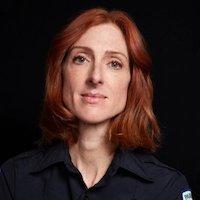When you click on a sponsoring school or program advertised on our site, or fill out a form to request information from a sponsoring school, we may earn a commission. View our advertising disclosure for more details.
“The second you put on a uniform people forget you’re a human being. They call you a hero. Endow you with superhuman qualities you may or may not possess. Bravery. Strength. Resilience.”
These are the first lines of Jennifer Murphy’s new book, First Responder, a revealing firsthand account of life as an emergency medical technician (EMT) in New York City. Murphy began her career as a first responder just two years before the onset of the pandemic. When the coronavirus spread through the metropolis in the spring of 2020, she decided to put pen to paper.
But more than a riveting story of how the nation’s most populous city handled the greatest public health threat in 100 years, Murphy’s account provides valuable insight into the realities of the job for anyone considering a career in emergency medical services (EMS.)
In honor of National EMS Week (May 16-22, 2021), we spoke with Murphy about her journey to becoming an EMT, what she wishes the public knew about life as a first responder, and her advice to those who are considering the profession.
Meet the Expert: Jennifer Murphy, EMT & Author

Jennifer Murphy has been a volunteer EMT in Brooklyn, New York since 2018. In addition to her EMT work, she maintains a parallel career as an investigator, crisis adviser, and author. Her writing has appeared in Mississippi Review and Wrath-Bearing Tree, Forbes, and the New York Post.
She holds a BA from Syracuse University, an MA from the University of Chicago, and an MFA from New York University.
The Challenges of Being an EMT
Learning to Cope With Trauma
You may have heard that becoming an EMT is a quick and easy process. While it’s true that there is a relatively low barrier of entry to the field, you shouldn’t underestimate the demands of the job before jumping in with both feet.
The first and most basic level of training—EMT-Basic or EMT-B—is available through many community colleges and other institutions. It usually only takes four to six months to complete the 120 to 150 hours of training, in which you’ll learn how to diagnose patients, treat them, operate emergency vehicles, and document cases for the doctors. But learning doesn’t stop in the classroom.
“There’s a big leap from studying EMS in a textbook, being trained in a classroom, practicing CPR on dummies, and doing skills drills during training to working in the field,” Murphy said. “It’s really a kind of leap of faith and it can be quite challenging to just go from a classroom study setting onto an ambulance with dynamic environments and real people in real emergencies. I think it’s quite a severe learning curve.”
In her book, Murphy describes the first time responding to a serious trauma case—a delivery biker who’d been hit by a car—in the summer of 2018, just a few months after getting her EMT license:
“There was so much happening all at once. Everyone in action but me, drowning in a sea of surreally slow time. There were voices all around me, but I couldn’t tell where they were coming from. I heard only a high-pitched ringing in my ears. It wasn’t just the guy laid out in the street with blood guttering from his forehead, darkening his face and spilling into his eyes, his legs twisted to the side as if he were running. It was the swarm of firefighters encircling him, then looking at me, waiting, expecting me to do something.”
“Now, after a few years in the ambulance, that wears off and you don’t have the same reaction every time, but at the beginning, that was certainly something I wasn’t prepared for,” Murphy said. “It’s challenging to learn how to process some of the things you’re seeing in the field.”
Because of the trauma that EMTs and paramedics are exposed to on the job, they experience higher rates of PTSD, major depression, substance abuse, suicide, and increased risks of physical health problems than the general population, according to studies in the U.S. and England.
“It’s really a career you can fall in love with, but you have to stay balanced and take care of yourself while you’re doing it or the price becomes too high,” Murphy said. “[You have to learn] not to be shy about asking for mental health care if you see things on the street that cause you distress because it’s a career that asks a lot of you.”
Unfortunately, the stigma associated with seeking counseling has prevented many first responders from getting the help they need. According to a recent University of Phoenix survey that looked at EMTs’ perceptions about mental health, nearly half felt that there would be repercussions on the job for seeking professional counseling, mainly due to being perceived as weak by colleagues and peers.
Organizations like Code Green and Give an Hour are helping to break down the stigma around seeking help for mental health issues and increase their access to resources.
Low to No Pay
Despite the level of stress that first responders endure on a daily basis, the compensation that EMTs receive is dismally low, and in some cases, nonexistent. Some counties, especially in rural areas, rely on volunteer EMTs to serve their communities.
It hasn’t always been this way. In 1981, President Reagan cut taxes and eliminated federal funding for EMS, leaving states and cities to fend for themselves. In areas where local governments couldn’t collect enough taxes to keep EMTs on the payroll, volunteers stepped up to the plate.
Even in areas where EMTs do receive pay, wages are hardly livable. EMTs rank fourth from the bottom in salaries of all jobs in the country, outpacing just preschool teachers, meatpackers and dishwashers. Their national average yearly income is $29,924 a year. In New York City, garbage collectors make more money than EMTs.
“I’ve never met a firefighter, a police officer, an EMT, a paramedic, or even a politician who believes that EMS workers earn fair wages,” Murphy said. “It’s one of the worst paid occupations in the country and it’s certainly one of the worst paid among the first responder world.”
This is a big reason why the median career expectancy for EMTs and paramedics is only five years; eventually, they tend to move on to other professions within the medical field with better pay.
“It’s a bit sad, the lack of funding, because you have a lot of people who would prefer to work in the field in prehospital emergency care, but they’ll go for nursing because of the benefits and the salary,” Murphy said.
The Rewarding Aspects of EMS Work
Despite the emotional and financial burdens that come with the territory, many career EMTs will tell you that being a first responder is more than a job—it’s a calling.
“For me, the rewarding aspects are numerous. The sense of belonging to a community of like-minded souls is really, really powerful. Being part of something greater than yourself, helping people in need. I also find it deeply rewarding to be capable and trained, to act in an emergency rather than being helpless or simply feeling like I’m watching a disaster as a witness or as a bystander. It’s a tremendous feeling to be trained to act,” Murphy said.
Above all, Murphy would like both potential EMTs and the general public to know that first responders are just regular people; they don’t have an innate heroic quality that the common person does not possess.
“I’m a big advocate of training everyday people to become first responders because it’s not that the skills themselves are particularly extraordinary. Becoming brave in the field is just a matter of practice,” she said.
“If you practice, you get better at it. So it’s not as if a certain class of heroic people is born into it. My partners are every race and nation, every gender, every sexual orientation. It’s pretty incredible.”
In 1974, President Ford created EMS Week to celebrate EMS practitioners and the selfless work they do for our communities. May 16-22, 2021 will be the 46th annual EMS Week.
This year, EMTs deserve to be celebrated more than ever before. EMS personnel are at a higher risk of dying from Covid-19 than other healthcare or emergency services professionals. In fact, it is estimated that the number of EMS personnel in Covid-19 related deaths is about three times higher than nurses and about five times higher than physicians.
“Especially after 2020, all of us are very burned out, but I am still on it. I’ve gone back to the ambulance after taking a big break and I have tremendous respect for people who choose to do this line of work,” Murphy said.
Whether you’re an aspiring EMT or a civilian, First Responder is a must-read. You can find a copy through various retailers here.
